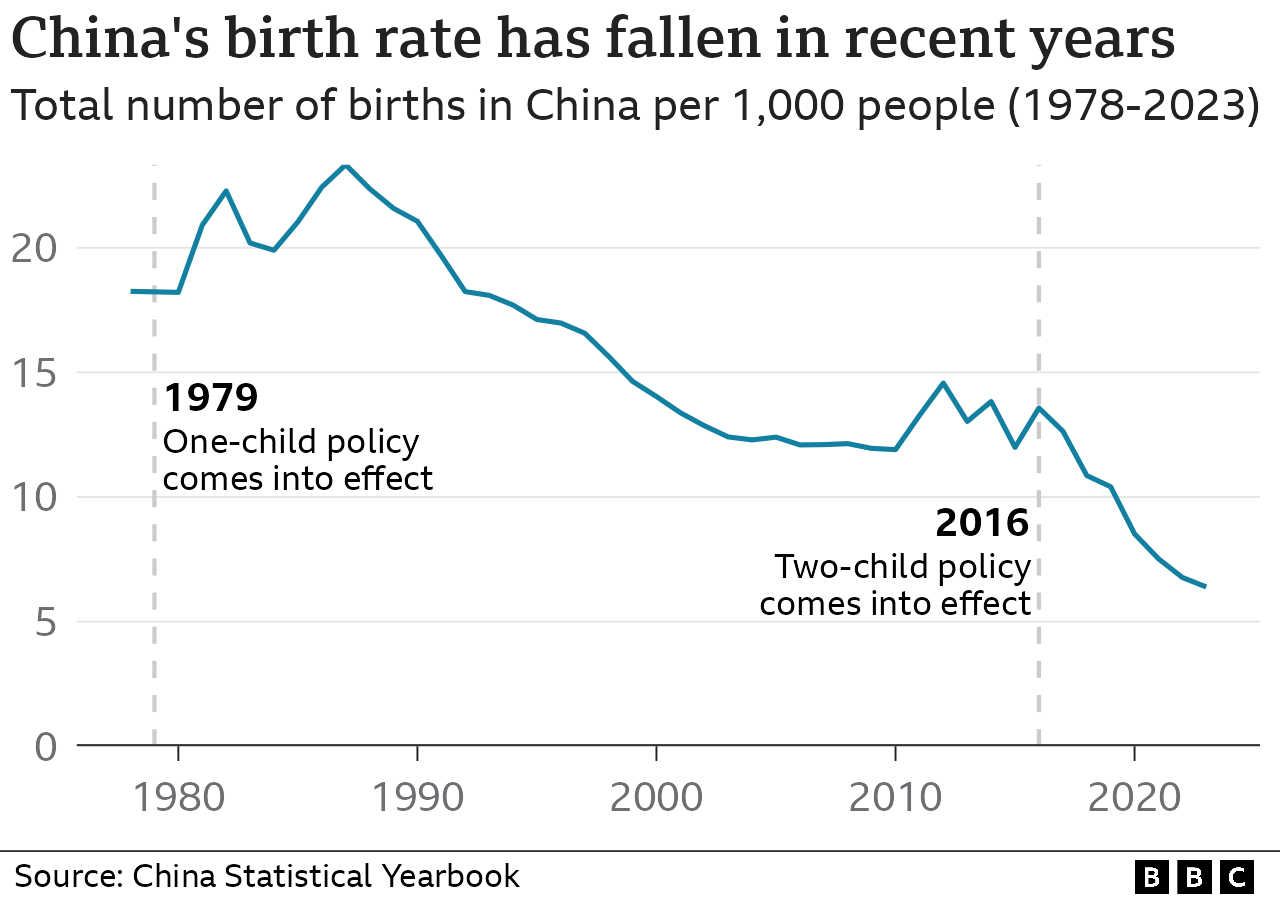2023 brought a double whammy for China: a record low birth rate and a second consecutive year of population decline. This demographic shift isn’t just a statistic; it’s a seismic tremor shaking the very foundation of the world’s second-largest economy. Let’s unpack the key takeaways:

Birth Rate: Diving Deeper
- Plummeting numbers: China’s birth rate dropped to 6.39 births per 1,000 people, the lowest since the Communist Party took power in 1949.
- Fewer new faces: 9.02 million babies were born in 2023, down from 9.56 million in 2022.
- Reasons for the decline: A mix of factors, including ongoing economic woes, pandemic anxieties, and cultural shifts that are making young couples hesitant to have children.
Population: Shrinking and Aging

- Negative growth: China’s total population dipped to 1.409 billion, down 2.08 million from 2022.
- Shrinking workforce: The working population aged 16-59 declined by 10.75 million, adding to a long-term trend.
- Graying future: The population over 60 continues to expand, with over 297 million people now in that age bracket.
Economic Ripples:
- Growth sputters: China’s economy grew by 5.2% in 2023, missing the government target and marking one of the country’s worst performances in 30 years.
- Investor jitters: Chinese stocks took a tumble on Wednesday following the population data release, highlighting investor concerns about the long-term economic outlook.
- Reshaping sectors: The shrinking population will force Beijing to make structural changes in sectors like healthcare and housing to adapt to a new demographic reality.
Government Response:
- Boosting the “silver economy”: The government is focusing on developing products and services for the growing elderly population, aiming to tap into their spending power and ease the burden on social services.
- Encouraging procreation: Policies like relaxed family planning restrictions and financial incentives haven’t yielded significant results so far.
What Lies Ahead?
- Experts predict further decline in birth rates and population shrinkage in the coming years.
- The aging population will strain healthcare and pension systems, posing a significant challenge for the government.
- China’s economic growth is likely to face headwinds from the demographic shift, requiring strategic adjustments in various sectors.
Beyond the Numbers:
This demographic shift isn’t just about statistics; it’s about human stories. It’s about young couples making tough choices about their future, it’s about families grappling with the challenges of an aging population, and it’s about a nation adapting to a new chapter in its demographic history.
While the challenges are significant, China’s resilience and adaptability shouldn’t be underestimated. The question remains: how will the country navigate this new demographic landscape and build a sustainable future for its people? Only time will tell.
Key Takeaways:
- China’s birth rate is at a record low, and the population is shrinking for the second year in a row.
- The aging population and shrinking workforce pose significant challenges for the economy and social services.
- The government is focusing on developing the “silver economy” and encouraging procreation, but the long-term effects remain uncertain.
- This demographic shift has profound implications for China’s future and raises questions about its ability to maintain its economic and geopolitical influence.
Stay tuned as this story unfolds, and keep an eye on how China tackles the challenges and opportunities presented by its changing demographics and develop the silver economy
This blog post aimed to provide a concise and informative overview of China’s demographic crisis, avoiding excessive jargon and lengthy sentences. Feel free to explore the links provided for further details and to dive deeper into the specific topics that pique your interest.
Possible ways to Save China’s Shrinking Future
Empowering Families:
- Reduce childcare burdens: Offer affordable and accessible daycare, extend maternity leave, and incentivize flexible work arrangements.
- Financial support: Direct cash benefits, housing subsidies, and tax breaks for families with children.
- Cultural shift: Promote positive narratives about parenthood and address societal pressures that deter childbearing.
Rejuvenating the Workforce:
- Extend retirement age: Gradually raise the retirement age to tap into the experience and skills of older adults.
- Upskilling and reskilling: Train and retrain existing workforce for critical industries, including automation and AI integration.
- Attract skilled immigrants: Offer streamlined visa processes and incentives for professionals in needed sectors.
Embracing the “Silver Economy”:
- Invest in healthcare: Upgrade medical infrastructure and expand elder care services to cater to the aging population.
- Develop senior-friendly technology: Promote solutions that improve mobility, social engagement, and independent living for the elderly.
- Unlock senior spending power: Create products and services tailored to the needs and interests of older adults, boosting the “silver economy.”
These are initial steps, but tackling China’s demographic challenge requires continuous adaptation and long-term planning. Prioritizing family well-being, workforce flexibility, and senior care can help navigate the transition, fostering a sustainable future for the nation.
